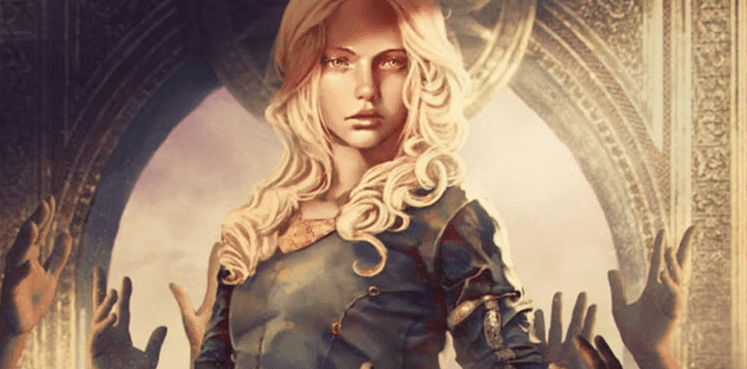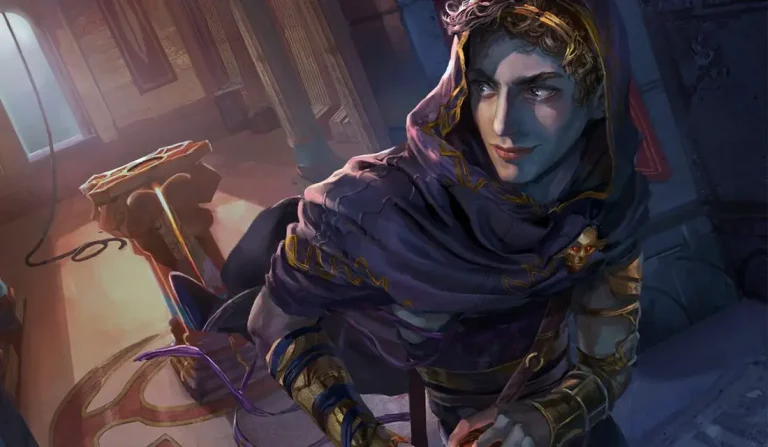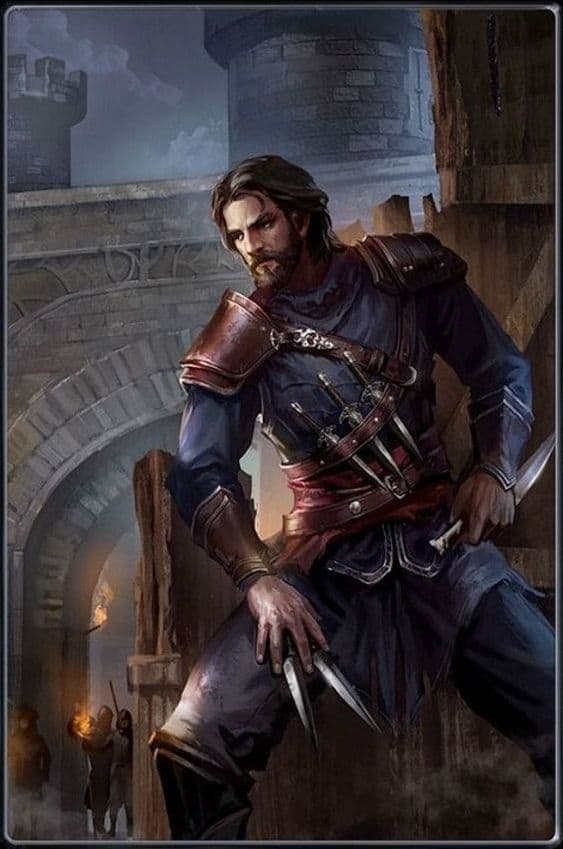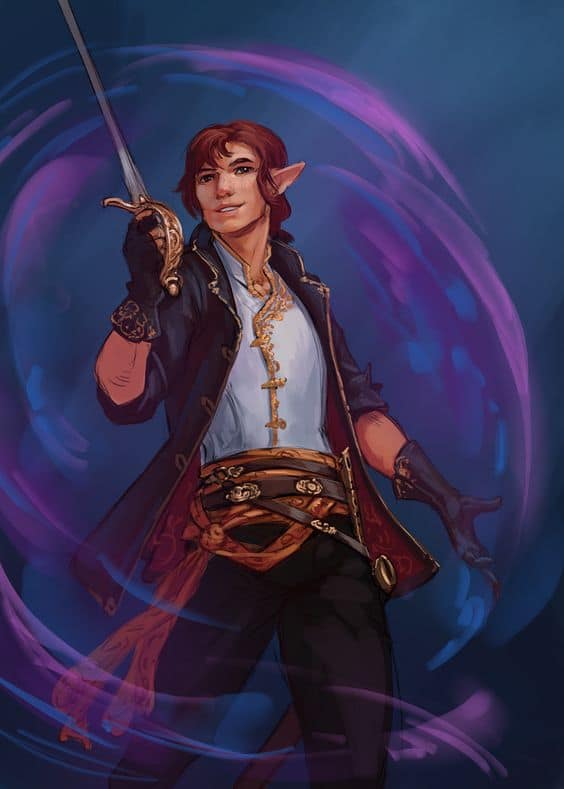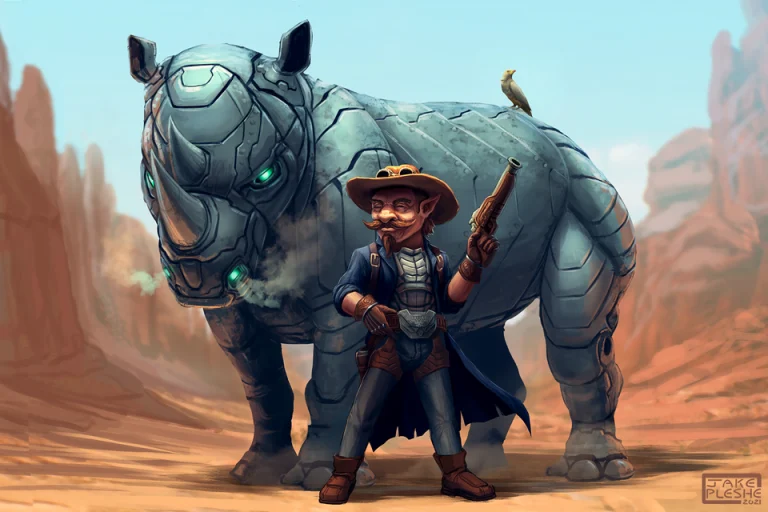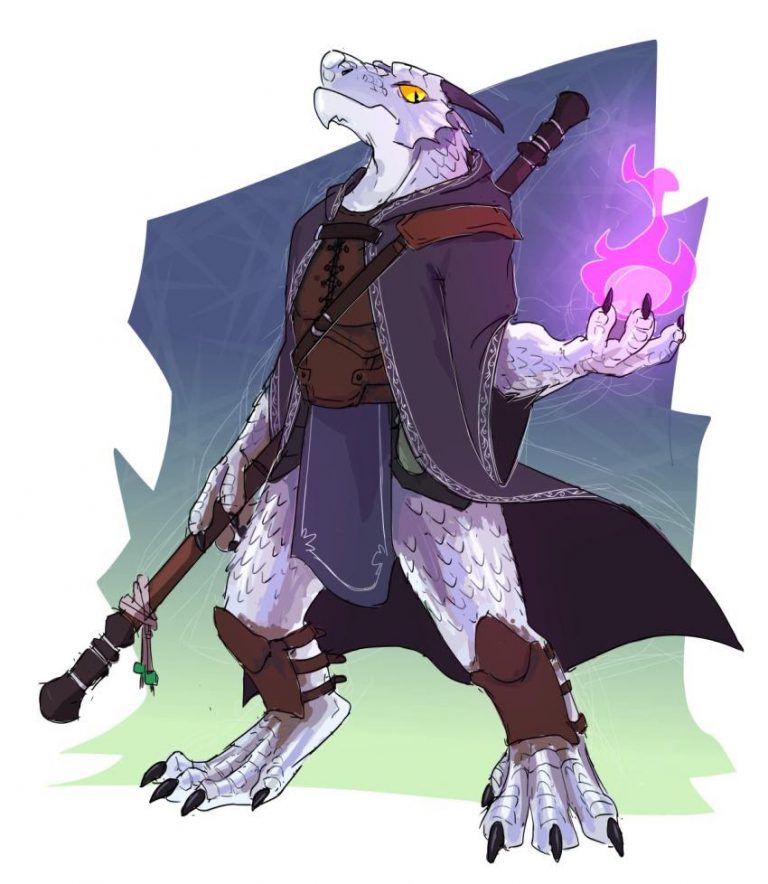D&D 5e: The Hexblade Warlock Guide
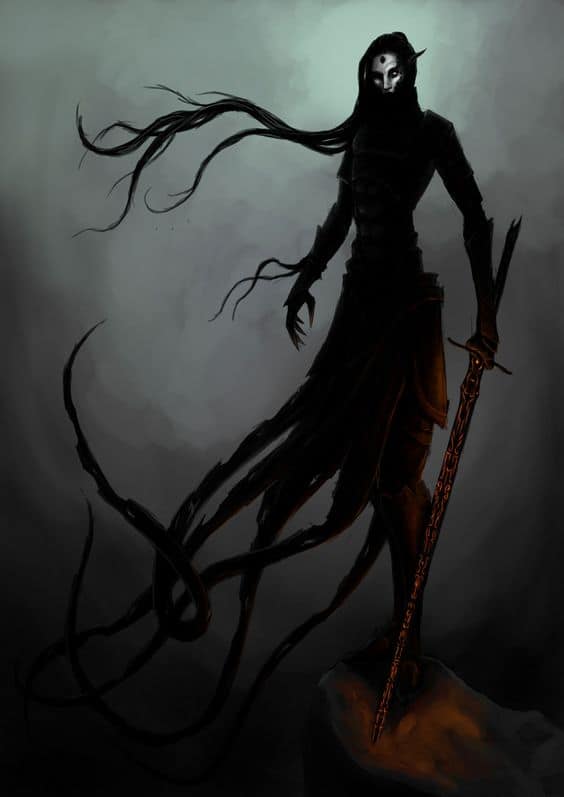
D&D 5e: The Hexblade Warlock Guide
Role in the Party
Appearances can be deceiving. The Halfling had walked into the tavern, awkwardly clutching a sword, clad in mail armor that hung poorly, big enough that it looked like it had been stolen from someone much bigger, all ready smiles and nervous laughter. Nothing suggested that this was a seasoned warrior.
Until they entered the dungeon, and the darkness simply swallowed them up. Until battle was joined for the first time, and they erupted into blue fire, swords glowing with runes that leaped from the blade with every swing. Until a gesture sent a lance of crackling energy into the back of the last, fleeing foe. Until they turned back to the party with a shrug and an expression that suggested that this was all in a day’s work.
The Hexblade is one of the most versatile classes in the game. Comfortable wading directly into combat or throwing out spells and cantrips from the back lines, it can be built to perform many different roles. This guide breaks down the Hexblade subclass, its strengths, potential ways to build the class, effective feat and skill choices, and more.
Epic
Good
Meh
Bad
The Hexblade Warlock subclass is found in Xanathar’s Guide to Everything. Click here to pick up your own copy of Xanathar’s Guide to Everything!
Hexblade Features
Expanded Spell List: The Hexblade adds extra spells to the base Warlock spell list. The Warlock can choose any of the spells below at the levels they become available, adding them to spells known as normal. This is a good list, mixing defensive buffs and smiting that help with melee combat, with some solid blasting options.
1st Level:
Shield: A reaction for +5 AC until your next turn is incredible defense. This spell remains useful even at 20th level. Take it.
Wrathful Smite: A small amount of psychic damage, but the Frightened condition is incredibly powerful if it sticks. This is probably the best low level smite spell.
2nd Level:
Blur: Disadvantage to hit you for a minute unless the target has one of a small list of buffs. Needs concentration, but a powerful defense.
Branding Smite: A reasonable spike of damage, but the ancillary effect, lighting up invisible enemies, is too niche to be worth it.
3rd Level:
Blink: A 50% chance to disappear at the end of your turn, until the start of your next turn. A great spell for you, but random, and can put pressure on your party instead.
Elemental Weapon: Add hit bonuses and elemental damage to a weapon. The choice of damage is great to bust through resistances, but at this level, AOE blasts will probably be more efficient.
4th Level:
Phantasmal Killer: Ongoing Frightened condition and a surprisingly large amount of damage. If the target keeps failing saves, this spell can remove them from the fight entirely, and might even just kill them.
Staggering Smite: Reasonable damage and a good effect, though it’s a single target, one-turn spell, for half your spell slots. Phantasmal Killer might be better.
5th Level:
Banishing Smite: A big chunk of force damage, and an irresistible banishing effect that’s surprisingly reliable if you can predict enemy HP levels.
Cone of Cold: Synaptic Static, available at the same level, does the same damage in a radial AOE, which can be easier to land, and forces an INT save for an effect that directly reduces enemy rolls. Compared to that, Cone of Cold is … mostly just fine.
Hexblade’s Curse: From level 1, the Hexblade gains the ability to curse their enemies. As a bonus action, a creature within 30ft is cursed for a minute, or until it’s dead. This does several things:
-
Adding your proficiency bonus to damage rolls
-
Critically hitting on 19-20, instead of just 20
-
When the cursed target dies, you regain HP equal to your Warlock level + CHA bonus
This ability can be used once, refreshes on short and long rests, directly competes with the Hex spell, and is 100% a worthy alternative.
The damage bonuses, both the direct boost and the boost to critical hits, spike your damage much higher, and stack with all other sources of damage. They also scale and act as a bonus on every attack roll you make.
So if you, as an example, cast Eldritch Blast, firing off three beams at 11th level, you gain a +4 bonus to damage on each one that hits, with doubled chances for a critical hit. That’s large and allows the Hexblade to be one of the most effective damage dealers in the game when they stack all of their bonuses.
The health gain is a nice bonus, too, especially when you drop it on a major enemy, and can help with resource management for the party.
Hex Warrior: This ability defines the Hexblade. It offers proficiency in Medium Armor, Shields, and Martial Weapons. That’s the full suite of gear, and it’s a significant durability boost for the class.
But it’s the second part of this that makes such a difference. After a long rest, pick a one-handed weapon and touch it. Now you can make attack and damage rolls using CHA instead of a physical stat.
This is so powerful it’s untrue, and turns the Hexblade into a true single stat class. Everything you want to do, from casting spells to hitting people with a sword to skills, now keys from your Charisma. This lets the character pour all of their statistic increases into one stat, and makes it much easier to get stronger.
The ability also gets much stronger, depending on the choices of Warlock Pact and Eldritch Invocations. Just don’t get disarmed.
Accursed Specter: From 6th level, the Hexblade can pull free a fragment of the spirit of any humanoid they kill, animating a Specter, which comes into being with a bonus to attack equal to your CHA modifier, temporary HP equal to half your level, and follows all of your commands.
The Specter lasts until your next long rest, and the ability can only be used once per day.
As a combat ability, this is reasonable. While the Specter doesn’t do much damage, the fact that it’s incorporeal means that it can easily travel through walls and ambush the targets it has a chance of killing. Specters are also resistant to most damage types and a ton of effects, so they can eat an attack or two, which can be worth using the ability by itself.
But it’s the out of combat utility that makes this great. Specters have a fly speed of 50ft, are incorporeal so they can pass through walls, but they can interact with the physical world, so could easily scout rooms for you, pick up keys from inside rooms, and post them out of windows, steal things, assassinate people in their sleep…
There are two issues, though. One, a lot of how this ability operates is due to GM fiat, as it doesn’t specify certain things about the Specter’s alignment and temperament towards you, or in general, as Specters are supposed to be innately evil beings.
Two, it only works when you kill humanoids, and you specifically have to slay them, which means if your party strikes the killing blow instead, this doesn’t work. Considering you might not even face humanoid enemies in many combat encounters, that can limit the number of times this is used if it’s even used at all.
Armor of Hexes: From 10th level, the Hexblade’s Curse only grows defensively more powerful. If the target under the Hexblade’s Curse hits the character, roll a d6. On a 4+, the attack simply misses.
This ability is absolutely disgusting. Flatly avoiding 50% of attacks that come your way from the enemies that you curse is an absurdly powerful defensive ability. There’s also no way around it, or to avoid it. You curse an enemy, and they miss you half the time. Stack with the rest of your defensive buffs, like Blur, to become almost unhittable using standard attack rolls.
Master of Hexes: From 14th level, the Hexblade’s Curse is infectious, spreading from enemy to enemy. When an enemy that’s Cursed by the Hexblade dies, you can spread it to another target within 30ft of you.
You don’t get the healing from the ability when you do this, but the healing was never why you were Cursing enemies anyway. At level 14, the damage boost and crit bonus are far more valuable, and being able to shift that from enemy to enemy as you kill them, one by one is an incredible boost to the ability.
Read More: Complete 5th Edition Warlock Guide
Strengths
Ah, the Hexblade. Widely regarded as one of the strongest subclasses in 5e. It’s genuinely hard to build a bad character using the Hexblade because everything that it offers is so simple, yet so powerful.
Firstly, the single biggest change the class offers is the ability to fight on the front lines while still only pumping Charisma. Being able to use your CHA bonus to attack, whether you’re swinging an ax or blasting out force bolts, means that building an effective character who can fight in all situations is easy.
The Hexblade is significantly tougher than every other Warlock subclass, and also much tougher than basically every other main caster in 5e. While it’s not as tough as front line warrior classes like the Fighter or Paladin, it also does things that those classes simply cannot replicate.
As the class levels, the power simply piles up. Eldritch Invocations let the Hexblade specialize in almost any sphere of the game. Warlock Pacts can further push melee ability or add a massive amount of utility with the best familiar in the game, or ritual casting and other bonuses.
In later levels, the core abilities of the subclass only get stronger, both through unlocking more features that interlock with what’s already been gained and through existing features gaining more scaling power.
Outside of combat, the Hexblade is an incredible asset to the party. Natural affinity towards social skills, the option to take multiple utility spells and abilities, and design space enough to specialize in anything, without actually harming the overall efficacy of the character’s main role.
Finally, it’s worth pointing out that the Hexblade is the single strongest multiclassing dip in the entire game. Any character that uses CHA to cast spells can take a single level of Hexblade to become much tougher, plus gaining the ability to act effectively in melee. Conversely, the Hexblade will happily take levels in basically every other class, spellcasting and martial both, and still end up in a strong, powerful build.
Weaknesses
The Hexblade has no weaknesses.
Hyperbole aside, the subclass itself has no real, glaring problems, like some subclasses do, but does share the standard, conventional weaknesses of the Warlock class:
Firstly, despite gaining proficiency in armor and shields and having several defensive options using their spells and abilities, the base class underneath still only has a d8 hit die. That means anything that makes it through your defenses is going to take a significant chunk out of your HP pool, and a concerted assault at most levels will put you at real risk.
Second, the Warlock suffers from incredibly limited spell slots. From level 2, it only ever has two per day. That’s it. The slots refresh on short rests, but these aren’t guaranteed, meaning that on some adventuring days you might only get to cast two spells, so they have to be good ones. At later levels, the Warlock unlocks high level spellcasting in the form of Arcanum, but this also comes with its issues.
Finally, the Hexblade can be good at almost anything. It happily accepts the roles of main melee DPS, secondary tank, skirmisher, ranged DPS, social face, and more. But it can’t be good at everything, and between skills, spells, invocations, and pacts, there are a lot of ways to build the character. It’s generally a better plan to pick one or two roles to excel at, instead of spreading yourself too thin and trying to be good at it all.
Best Race Options
Scourge Aasimar: The stats are excellent, as are a free cantrip, resistance to two types of damage, and a little bit of extra healing.
The Aasimar transformation, though, is a major boost to damage, hurting everything within a small radius, as well as boosting your hits. It does hurt you, and that can be slightly risky, so if you’re not a fan, lean into Protector for flight instead.
Eladrin Elf: Perception, bonuses against some conditions, Darkvision, and the weird Elf sleeping thing are all good features.
The main Eladrin feature, though, is a bonus action teleport that functions as Misty Step with an extra ability tacked on. Autumn and Winter are what you’re looking for, both triggering conditions on enemies close by, which ties in perfectly with the class’s aggressive playstyle.
Fairy: Variable stats can be put into DEX and CHA, small size isn’t a hindrance on your damage, and the extra spells known, with two free daily casts, are much appreciated on a class that’s so limited in daily spells.
But we’re here for the flight. A flight that’s only limited by wearing light armor, which isn’t a problem, and lets you dart around raining down spells, firing arrows of energy, or even just swooping down to stab your enemies yourself. The Hexblade didn’t need the ability to fly, but turning it down when it’s so freely available is just silly.
Choosing the Right Skills
Warlocks don’t have that many open skill slots, but they do have the option to be very good at certain skills.
Social skills, in particular Persuasion and Deception, tie into the naturally high CHA of the class.
Stealth is something that the Hexblade can choose to be good at, if they want to be, also backed up with spell support. Perception is useful for every character, and should probably also be grabbed.
Any spare skill slots can be spent on utility skills like knowledges, specifically things like Arcana, which governs magic, and Religion, which affects all of the myriad gods and divine phenomena that the party faces.
Fitting Feats
Great Weapon Master: GWM was already a good feat, but there’s a ton of natural synergy between this and the Hexblade.
Taking Blade Pact allows you to use two-handed weapons with your CHA bonus, which no other class can do. Hexblade’s Curse doubles your crit range, which increases the chance of bonus action attack triggering. And that’s without considering the other benefits of the feat. All in all, this is a strong choice for front line melee brawlers.
Inspiring Leader: The Hexblade wants to be on the front lines, but still only has a d8 hit die. Inspiring Leader adds a lot of temporary HP to the build, as well as offers the same to up to 5 allies.
Even better, it scales with both level and your CHA, and can be refreshed on short rests, which, as a Warlock, you’re probably aiming to get either way.
War Caster: Again, you want to be on the front lines, but you also want to be casting spells. War Caster helps with concentration checks and lets you opportunity attack using cantrips (be sure to find a way to get Booming Blade if you take this feat.)
Optimal Backgrounds
Courtier: Two social skills and two languages push the character towards the social role it excels at.
Criminal: Thieving skills, a gaming set, which is mostly fluff, but Thief’s Tools are near essential if the party doesn’t have them elsewhere.
Guild Artisan: The social skills Warlocks love, plus a language and Artisan’s Tools, which can add a lot of flavors as well as utility.
Multiclassing Options
Conquest Paladin: Smite is such a huge boost to damage that it’s worth taking two levels in Paladin just for that. But you also gain proficiency in Heavy Armor and a fighting style, plus some supplementary healing and access to the Paladin spell list.
Conquest, in particular, offers some defensive spells, as well as powerful channel divinity options; an AOE fear, and a huge hit bonus, that are excellent for the front line fighter the Hexblade wants to be.
Aberrant Mind Sorcerer: The Hexblade is just as comfortable a caster as it is a melee character, and taking levels in Sorcerer is one simple way to up your blasting potential.
The Aberrant Mind offers up a list of bonus spells that you were probably already going to take, which frees up your open slots for the more niche picks, as well as Metamagic to shift spells into more powerful forms, and, if you put enough levels into this class, the ability to cast all of your mind affecting spells with absolutely no visual or verbal signifiers, allowing you to mess with people at your leisure.
Eloquence Bard: The basic Bardic package builds well into what the Warlock brings; the Expertise and skills it gives you, as well as Inspiration, pushes the character towards skills and utility.
We want Eloquence to boost this even further, offering some serious consistency on the social skills that you’re probably good at, as well as the impressively powerful bonus action Unsettling Words, that directly subtracts from an enemy’s saving throw and makes your spells much more likely to go off.
Would I recommend playing a Hexblade Warlock?
If you’ve played any amount of 5e, there’s a good chance you understand just how strong the Hexblade Warlock is. It’s a subclass favored by power gamers because it offers such an incredible amount of low-level punch for almost no investment.
Does this mean the Hexblade is broken? Inherently, no. Is it going to unbalance your game? Not unless you’re actively trying to do that.
But is it an incredibly well designed subclass that’s fun to play, simple to understand, and able to comfortably slot into any party composition? Absolutely, yes.
There’s a reason everyone raves about the Hexblade. And if you haven’t played it yet, you owe it to yourself to give it a try.



